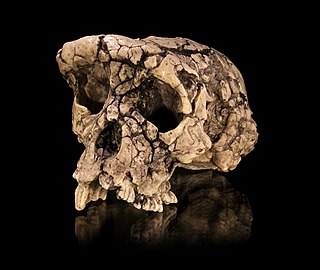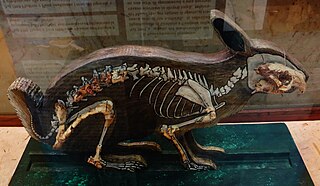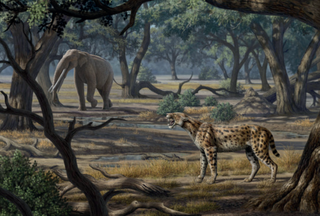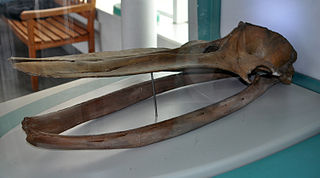The Pliocene Epoch is the epoch in the geologic timescale that extends from 5.333 million to 2.58 million years BP. It is the second and most recent epoch of the Neogene Period in the Cenozoic Era. The Pliocene follows the Miocene Epoch and is followed by the Pleistocene Epoch. Prior to the 2009 revision of the geologic time scale, which placed the four most recent major glaciations entirely within the Pleistocene, the Pliocene also included the Gelasian Stage, which lasted from 2.588 to 1.806 million years ago, and is now included in the Pleistocene.

Hippopotamids are stout, naked-skinned, and semiaquatic artiodactyl mammals, possessing three-chambered stomachs and walking on four toes on each foot. While they resemble pigs physiologically, their closest living relatives are the cetaceans. Hippopotamids constitute the family Hippopotamidae.

Sahelanthropus tchadensis is an extinct species of the Homininae dated to about 7 million years ago, during the Miocene epoch. The species, and its genus Sahelanthropus, was announced in 2002, based mainly on a partial cranium, nicknamed Toumaï, discovered in northern Chad.

Orycteropodidae is a family of afrotherian mammals. Although there are many fossil species, the only species surviving today is the aardvark, Orycteropus afer. Orycteropodidae is recognized as the only family within the order Tubulidentata, so the two are effectively synonyms.

Thylacinus is a genus of extinct carnivorous marsupials from the order Dasyuromorphia. The only recent member was the thylacine, commonly also known as the Tasmanian tiger or Tasmanian wolf, which became extinct in 1936 due to excessive hunting by humans. Other prehistoric species are known from this genus. An unidentified species is known from Pleistocene New Guinea.

Orycteropus is a genus of mammals in the family Orycteropodidae within Tubulidentata. The genus is known from Late Miocene to Recent of Africa.

The northern giraffe, also known as three-horned giraffe, is the type species of giraffe native to North Africa.

Ekorus ekakeran is a large extinct mustelid that inhabited late Miocene Kenya.
Australopithecus bahrelghazali is an extinct species of australopithecine discovered in 1995 at Koro Toro, Bahr el Gazel, Chad, existing around 3.5 million years ago in the Pliocene. It is the first and only australopithecine known from Central Africa, and demonstrates that this group was widely distributed across Africa as opposed to being restricted to East and southern Africa as previously thought. The validity of A. bahrelghazali has not been widely accepted, in favour of classifying the specimens as A. afarensis, a better known Pliocene australopithecine from East Africa, because of the anatomical similarity and the fact that A. bahrelghazali is known only from 3 partial jawbones and an isolated premolar. The specimens inhabited a lakeside grassland environment with sparse tree cover, possibly similar to the modern Okavango Delta, and similarly predominantly ate C4 savanna foods—such as grasses, sedges, storage organs, or rhizomes—and to a lesser degree also C3 forest foods—such as fruits, flowers, pods, or insects. However, the teeth seem ill-equipped to process C4 plants, so its true diet is unclear.
Physogaleus is a small genus of prehistoric shark that lived from the Eocene to Miocene epochs.

Oncorhynchus rastrosus also known as the sabertooth salmon, is an extinct species of salmon that lived along the Pacific coast of North America, first appearing in the late Miocene in California, then dying out some time during the Early Pliocene. Adults grew to be 2.29 m (7.5 ft) in length and are believed to have been anadromous like their living relatives. Besides being the largest member of the Pacific salmon genus Oncorhynchus, members of this species had a pair of small "fangs" protruding from the tip of the snout, thus explaining the common name and synonym. Beyond their fangs, adults of O. rastrosus had larger gill rakers compared to their smaller, modern relatives, leading scientists to suggest that the adults ate plankton.

Eucyon is an extinct genus of medium omnivorous coyote-like canid that first appeared in the Western United States during the late Middle Miocene 10 million years ago. It was the size of a jackal and weighed around 15kg. Its species E. zhoui was one of a number of North American mammals which invaded East Asia around 5–6 million years ago, followed by the genus going extinct 3 million years ago. This genus is proposed to have given rise to genus Canis 6 million years ago.

Paracamelus is an extinct genus of camel in the family Camelidae. It originated in North America during the Middle Miocene but crossed the Beringian land bridge into Eurasia during the Late Miocene, approximately 7.5–6.5 million years ago (Ma); its later range spanned from Spain and Italy to Chad and Shanxi Province, China. It is ancestral to living camels of the genus Camelus. A population remained in northern North America, which became the high Arctic camel, which survived until the Middle Pleistocene approximately 1 Ma.

Hypolagus is an extinct genus of lagomorph, first recorded in the Hemingfordian of North America. It entered Asia during the early Turolian and spread to Europe not much later, where it survived until the Middle Pleistocene. Though unknown in the Iberian Peninsula, fossils of this genus have been found in the Balearic Islands, suggesting an eastern migration during the dry period in the Mediterranean region known as the Messinian Salinity Crisis.

Lokotunjailurus is an extinct genus of saber-toothed cats (Machairodontinae) which existed in Kenya and Chad during the Miocene epoch.
The Djurab Desert is a desert in northern Chad. Part of the greater Sahara desert, it makes up much of the area of Chad's Borkou region.

Piscobalaena is an extinct genus of cetaceans, which lived from the Middle to Late Miocene epochs in Peru and Florida. Its fossils have been found in the Pisco Formation of Peru and the Bone Valley Formation of Florida. At least some individuals of this diminutive whale were preyed on by the shark C. megalodon.
Amphiorycteropus is a genus of mammals in the family Orycteropodidae within Tubulidentata. The genus is known from Middle Miocene to Early Pliocene of Africa, Asia and Europe.

Brachydelphis is a genus of pontoporiid known from the Late Miocene Pisco Formation of Peru and the Bahía Inglesa Formation of Chile.
Thylacinus yorkellus is a fossil species of carnivorous marsupial, a sister species of the recently extinct Thylacinus cynocephalus, the Tasmanian tiger, both of which existed on mainland Australia.












